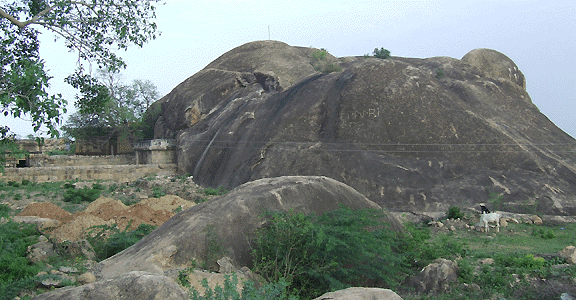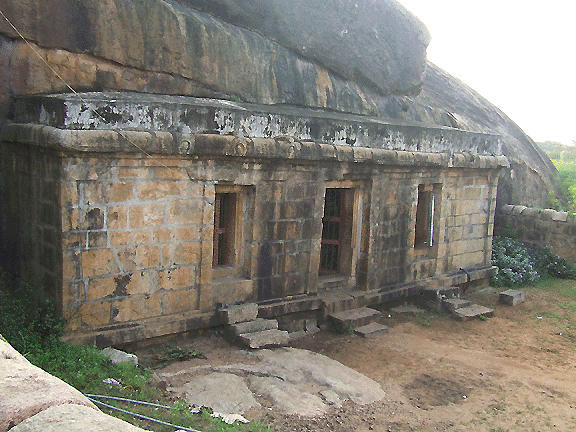
|
|
|
|
The Alathurthali and Olipathivishnu Graham cave temples are located in the same cluster of rocky hills, amidst large boulders. On the western side of the hill is the Olipathivishnugraham, which faces to the north. The temple complex has a wall enclosure with a north-facing gopura, and includes a mukhamandapa, ardhamandapa and sanctum sanctorum, which house the main cave and two subsidiary shrines near the gopura entrance.
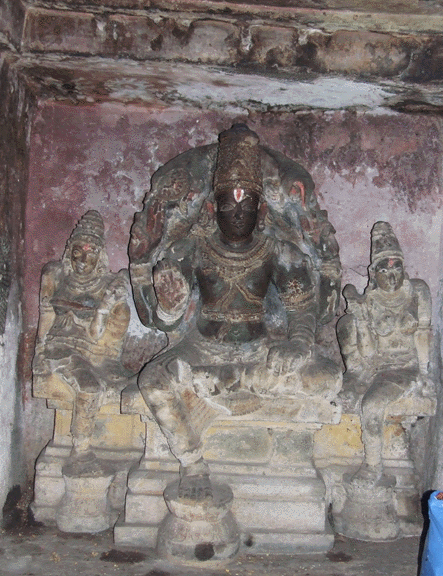
Sri Kanniraintha Perumal The presiding deity here is Kanniraintha Perumal (Visnu), and his consort is Nachiyar (Laksmi). They are joined by Lord Brahma and Shiva, along with Lord Nrsimhadeva and various other murtis. In front of the caves are three Azhwars and Vishvaksena, who is considered to be the commander-in-chief of Lord Visnu's army. The cave complex consists of a sanctum sanctorum and mukha mandapa with three
entrances, cut out of the mother rock. An additional structure was later built, adjoining the front entrances. The whole temple, from the facade to the sanctum – along with the
presiding deity Himself -- is comprised of bas relief rock sculptures with stucco and paintings.
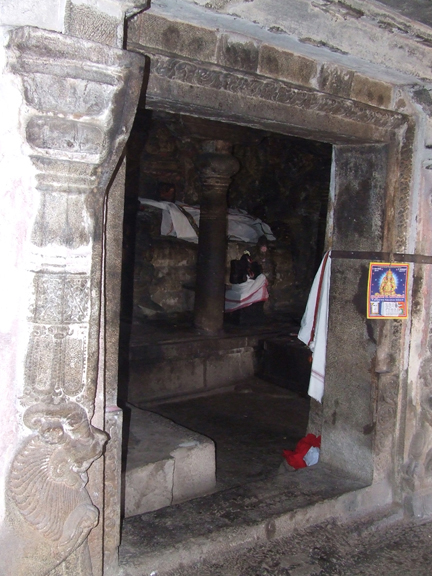
Sanctum sanctorum The gopura of Olipathivishnugraham has a flat roof that is ornamented with various elephants, birds and scrolls, with makaras projecting out at the four corners. A wall enclosure extends out on both sides of the gopura and meets the mother rock to the south. The eastern wall separates the two main caves, which are individual temple complexes. Because its built into a rock on a hillside, the overall complex is not on a flat plane, so the floor of the Shiva shrine sits at the same height as the top of the eastern compound wall. Outside of the gopura entrance on the left is Ganesh, who sits in a north-facing niche.
Inside the temple complex is a shrine for the presiding deity's consort, Nachiar (Goddess Laksmi), who faces east. She is seated in artha-padmasana, decorated with karandamakuta and ornaments. Her back hands hold lotus flowers, while her front hands are in abhaya and vara mudra. This shrine has a small mukha mandapa and sanctum, and the wall allows space so devotees can circumambulate the shrine.
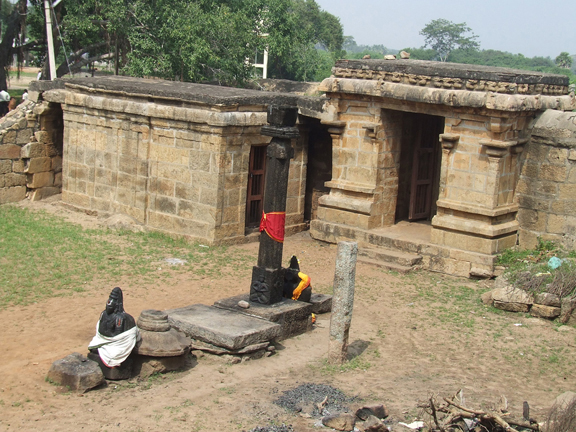
Temple Complex In the main shrine, Sri Kanniraintha Perumal and his consorts are depicted in stucco-covered bas relief panels sculptured along the length of the eastern wall. The three deities are standing on a pedestal cut from the mother rock. Vishnu is holding sangu (conch) and chakra, with one front hand in abhaya and the other on his left hip. A tiruvasi (arch) is above his head. To his right is Sridevi holding a lotus, and Bhudevi with lotus on his left. On either side of Visnu's head are flying figures of Surya and Candra, each offering flowers to the Lord. On the western wall of the mukha-mandapa, Visnu is depicted in a seated posture with his consorts. While these appear to be bas relief panels, on close inspection one finds that they are three separate pieces of stone, finely cut and joined.
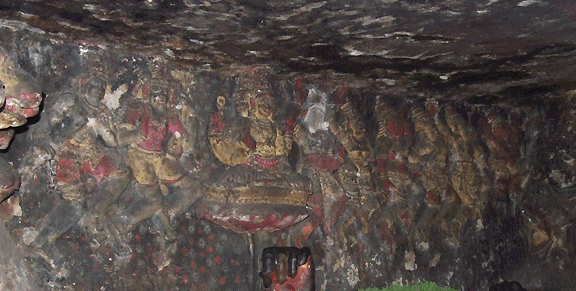
Lord Brahma On the southern wall of the main sanctum is a large bas relief panel depicting a reclining Visnu, with Brahmadeva in attendance above, sitting on a lotus. Flying around Lord Brahma's head are eight gandharvas, six on one side and two on the other. The gandharvas are engaged in worship of Their Lordships, singing and dancing. Lord Brahma is in ardha-padmasana, seated on a lotus. Wearing makuta and ornaments, he holds akshamala and lotus in his back hands, while the right front hand is in abhaya mudra, and the left rests on his thigh. To the right is another personality attending Brahma, being the sage Narada Muni, in short dress with jatamakuta, mustache and beard. He holds his veena with one hand, while the other is in kodi mudra. Beside him is another flying gandharva with the same paraphernalia. These two are glorifying Brahmadeva.
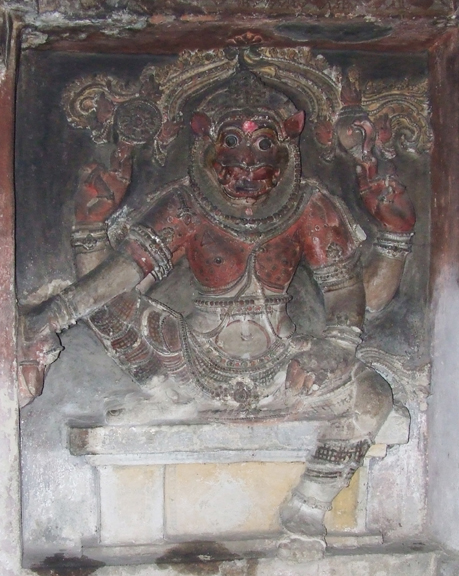
Lord Nrsimhadeva There are many other sculptures in the temple mandapas. On the southern wall are niches which house Lord Nrsimhadeva, Hayagriva, Krishna, Balarama, and Rama. The whole of the western wall is decorated by two large images of the demons Madhu and Kaitabha. The canopy of the mukhamandapa is fully covered with beautiful paintings of the Dasavatar. Also in the sanctum is a later sculpture of Lakshmi-narayana.
Another personality depicted here as offering worship to Their Lordships is a goat-faced Thakkan. He is in short dress, his right hand in kodi mudra, and his left in kataka mudra. Five other dancing figures are nearby. The two females in the party are dressed to the ankle, with karandamakuta and various ornaments. One dancer is smiling, one hand on her hip and the other raised up. The second has her left hand in vismaya. Two male dancers are also in the party, both with karandamakuta, short dress and ornaments. One dancer's right hand is holding his left, which is in vezha mudra. The other holds a flower in one hand, with the right hand raised in tripataka mudra. On the left is a gana, in short dress with rudraksha. He is dancing for the enjoyment of Visnu and Brahma, with both hands raised in the air.
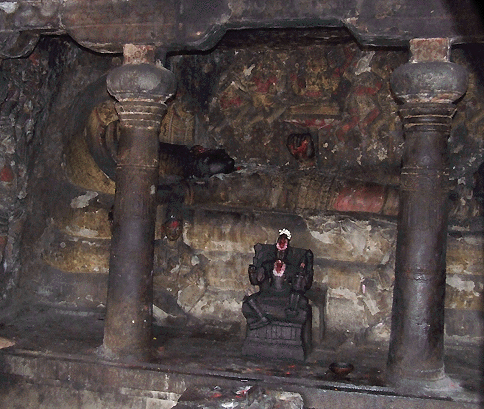
Lakshmi-narayana In front of the cave complex is a flagpole and balipitha (offering pedestal), with Devi and Garuda on either side. Garuda is seated in ardha-padmasana, with his feathers stretched out on both sides. He wears karandamakuta patrakundalas, charapali, bangles and ornaments, and his hands are in anjali hasta, towards the shrine. Many of the bas relief stone sculptures have been ornamented with painted stucco. Because the mulavigrahas or dhruva-bheras (temple deities and murtis) permanently installed in the shrines were made of destructible materials, like stucco-covered wood or stone, additional murtis (beras) made of metal or stone were also installed, to serve as the daily abhisheka and processional idols. This practice probably grew out of the later agamic prescriptions set down by priests in the South India temples.
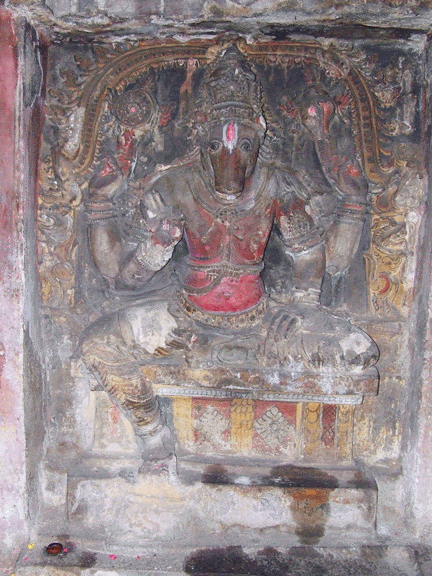
Lord Hyagriva
| |
